A systematic three-dimensional numerical model of atmospheric new particle formation (NPF) processes and the intricate chemical transformation of precursor gases has been established by Bin Zhao's research group at Tsinghua's School of Environment in collaboration with international scholars. This model has then been used to clarify global variability in atmospheric NPF mechanisms in conjunction with observational data.
Atmospheric new particle formation, the process of particle production by gaseous species through homogeneous nucleation, is the fundamental source of most particles in the atmosphere. New particle formation and the subsequent growth process may contribute more than half of the world's cloud condensation nuclei, thus having a significant impact on climate change; it is also the origin of many haze events and can cause serious damage to human health as well.
Previously, researchers have discovered a series of chemical mechanisms for NPF through laboratory experiments; other studies have also revealed NPF mechanisms at some sites through direct observation of molecular clusters (intermediates of particle production by gas molecules) in the atmosphere. However, the dominant pathways of NPF in most regions are still unclear; NPF remains one of the least understood aspects of atmospheric chemistry. Numerical modeling is an indispensable tool for clarifying the mechanisms and environmental impacts of NPF on regional and global scales. However, existing models failed to simulate many key processes involved in new particle formation and the chemical transformation of nucleation precursors, often resulting in order-of-magnitude biases between simulations and observations; this represents a significant bottleneck in the scientific understanding of NPF.
In response to the challenges above, Bin Zhao's research group has developed a systematic three-dimensional NPF model, the Community Model of Aerosol Nucleation (CMAN) based on its earlier research (Zhao et al., PNAS, 2020; ES&T, 2021; GRL, 2022; Li et al., ACP, 2023; Shen et al., EGUsphere, 2024). Compared with traditional models, which mainly consider the basic NPF mechanisms driven by sulfuric acid and ammonia, the new model comprehensively simulates 11 NPF mechanisms driven by multiple precursors such as sulfuric acid, ammonia, nitric acid, amines, other organic compounds, iodine oxoacids, etc. In order to accurately simulate the mechanisms above, on the one hand, molecular-level laboratory experimental results and molecular-cluster dynamic simulation are synthesized to establish parameterizations for NPF rates under different environmental conditions. On the other hand, to represent the complex sources, sinks, and chemical transformation of nucleation precursors, a three-dimensional model of organic oxidation based on the Radical Two-Dimensional Volatility Basis Set (R2D-VBS) is established to simulate the formation of ultralow and extremely low volatility organic compounds (ULVOCs and ELVOCs) that drive nucleation, and model schemes have also been developed to represent the emission, deposition, aerosol uptake, and multiphase chemical transformation and cycling processes of iodine oxoacids and amines.
Compared with a series of observation data, the new model reasonably reproduces the concentration of nucleation precursors and particles in different size ranges in various regions such as tropical rainforests, anthropogenically polluted regions, and oceans. The simulation error of particle number concentration decreases from about one order of magnitude to less than 30% in particle hotspot areas such as high-altitude areas of tropical rainforests, near-surface areas of anthropogenically polluted regions, and high-altitude areas of the ocean (Fig. 1a, Fig. 2a, Fig. 3a).
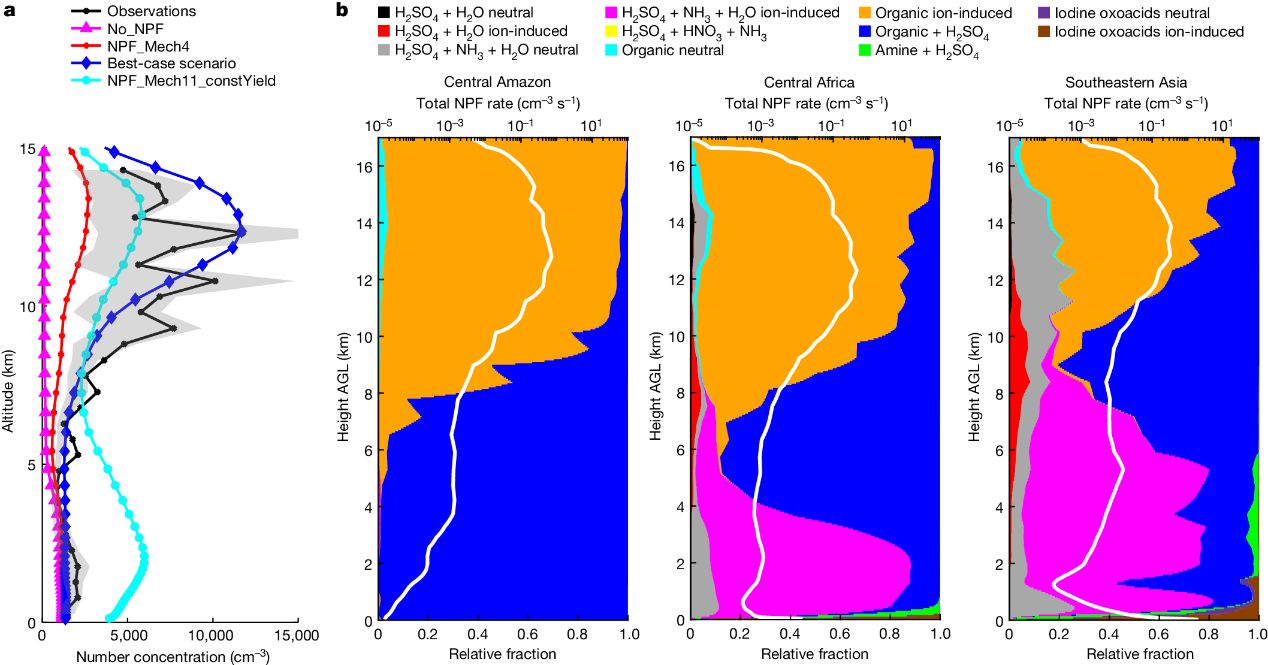
Fig. 1. Mechanisms of NPF and constraints from observations over rainforests. (a) Comparison of simulated particle number concentrations with aircraft measurements obtained over the Amazon; (b) Total NPF rates in 2016 (white lines) and proportion of each mechanism (colored areas) in every tropical rainforest region.
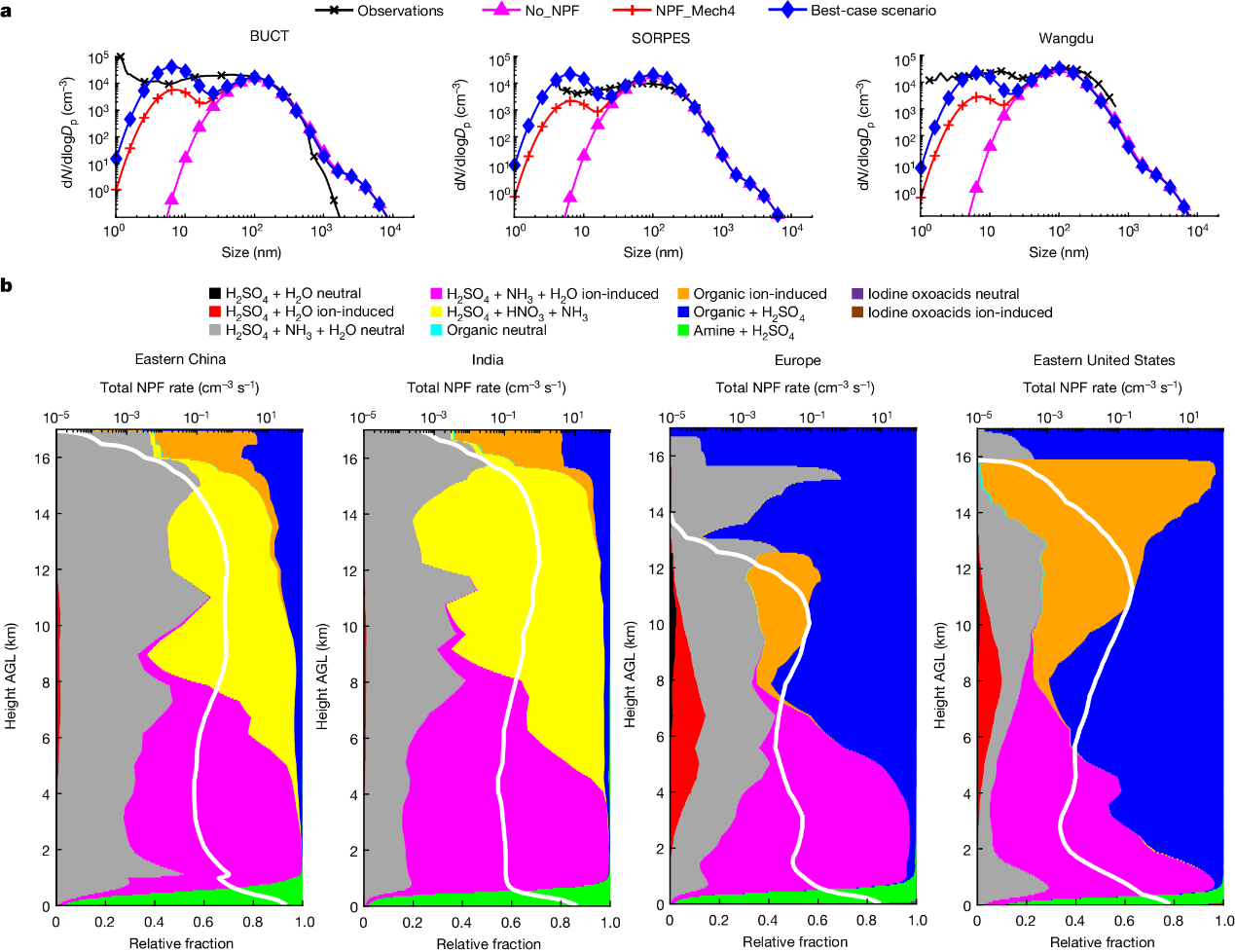
Fig. 2. Mechanisms of NPF and constraints from observations over anthropogenically polluted regions. (a) Comparison of simulated particle number size distributions with observations obtained at three sites in China; (b) Total NPF rates in 2016 (white lines) and proportion of each mechanism (colored areas) in every anthropogenic polluted region.
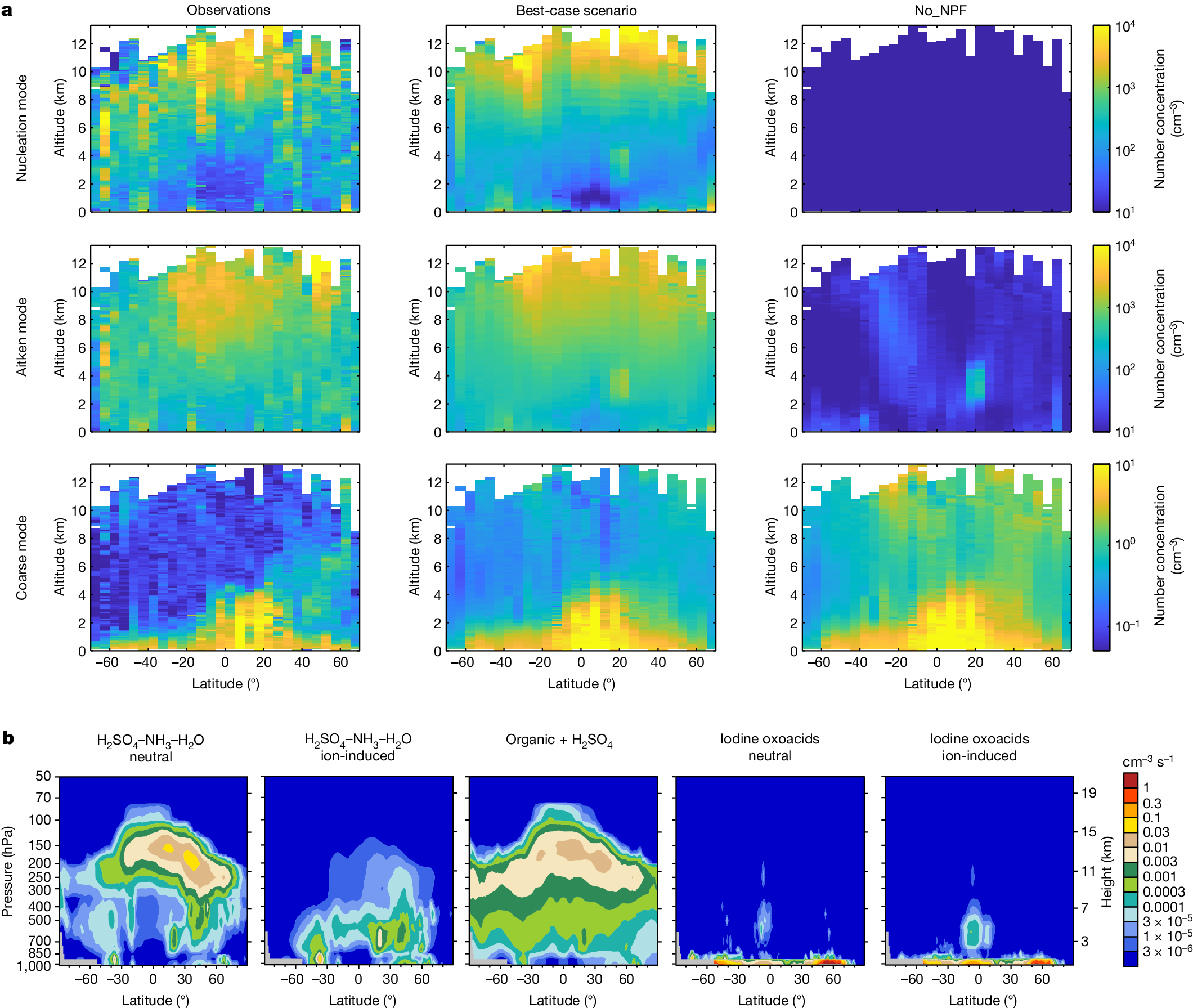
Fig. 3. Mechanisms of NPF and constraints from observations over oceans. (a) Comparison of simulated particle number concentrations of different modes with observations obtained over the Pacific and Atlantic oceans; (b) Zonal mean NPF rates of individual mechanisms over the Pacific Ocean in 2016.
Based on the new model and considering the constraints of observation data, a comprehensive picture of the NPF mechanisms all over the world is presented, demonstrating that the NPF mechanisms vary significantly with region and altitude. Taking the areas with high aerosol concentration or large aerosol radiative forcing as an example, the simulation results demonstrate that pure-organic nucleation dominates at high altitudes in tropical rainforests (Amazon, Central Africa, Southeast Asia, etc.) (Figure 1b); for anthropogenically polluted regions (China, the United States, India, and Europe), amine-H2SO4 nucleation is most likely to dominate near the surface, and H2SO4-HNO3-NH3 nucleation is likely to be the most significant mechanism at high altitudes in Asian monsoon regions such as China and India (Figure 2b); For the Pacific Ocean and the Atlantic Ocean, iodine oxoacids nucleation dominates near the surface, while organic-H2SO4 nucleation and H2SO4-NH3-H2O neutral nucleation are most likely to dominate at high altitudes (Figure 3b). The distribution of global zonal mean NPF rate is largely governed by the hotspot regions above (Figure 4). In the tropical upper troposphere, NPF is dominated by organic-mediated nucleation, especially pure-organic ion-induced nucleation that dominates above the altitude of 11 km. This reflects the NPF mechanisms over the rainforests and tropical oceans. In the boundary layer, amine–H2SO4 nucleation dominates in mid-latitude areas of the Northern Hemisphere, characteristic of anthropogenically polluted regions; iodine oxoacids nucleation dominates at other latitudes because of the vast oceans.
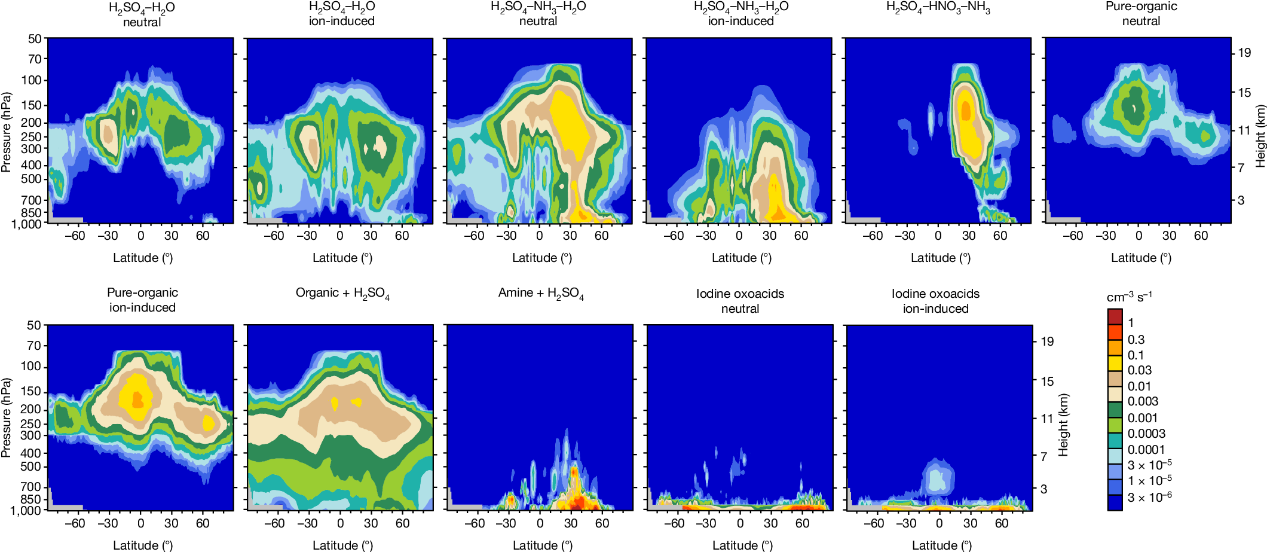
Fig. 4. Zonal mean NPF rates of individual mechanisms globally in 2016.
Besides the regional variability of NPF mechanisms, the contribution of NPF to cloud condensation nuclei also shows significant regional differences. For example, at the altitude of 1 km, where low clouds often appear, the contribution of NPF to cloud condensation nuclei under 0.5% supersaturation is between 10% and 80% (Figure 5).
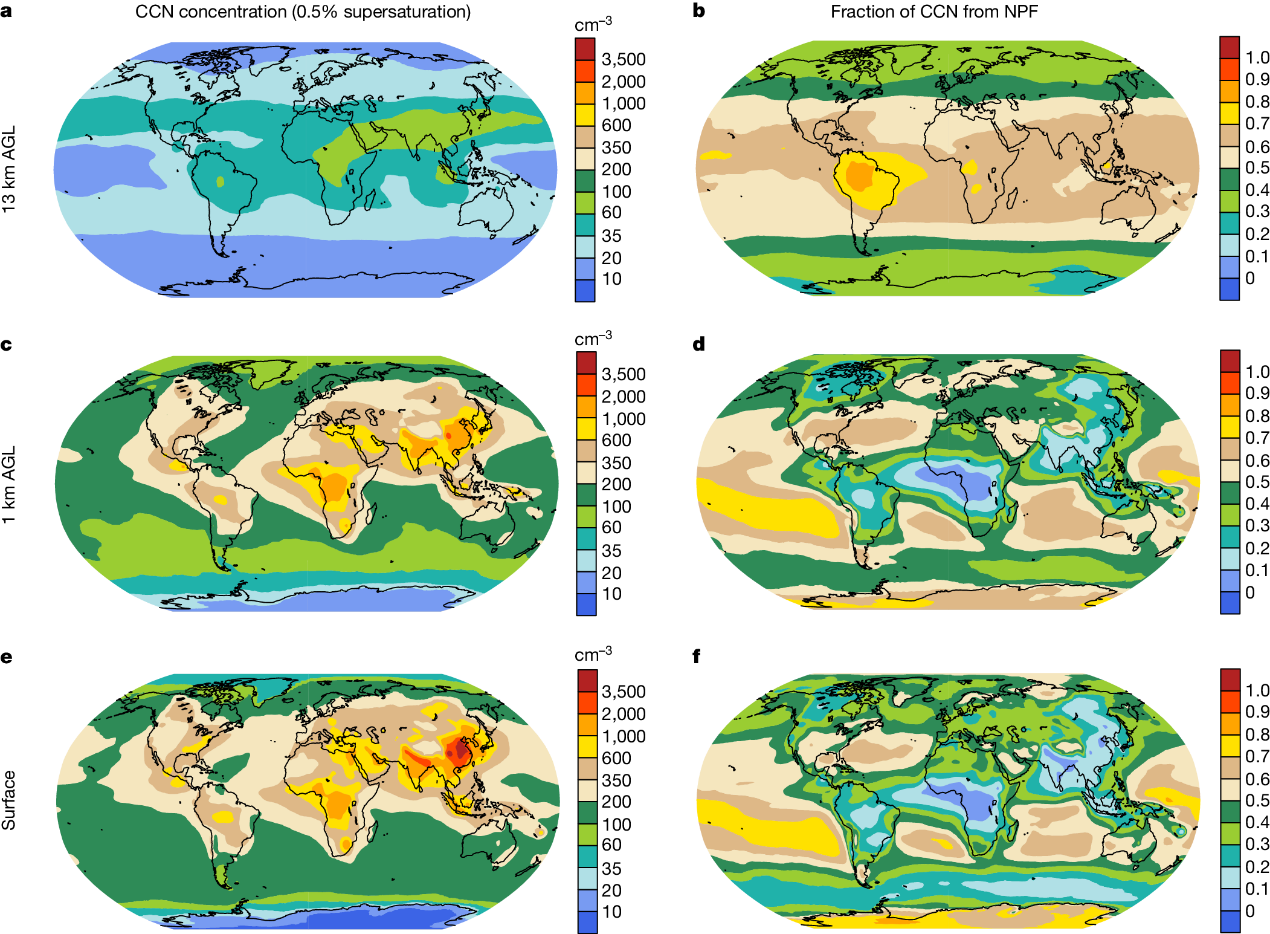
Fig. 5. CCN concentrations and fractions of CCN caused by NPF at different vertical levels in 2016.
To test the robustness of the conclusions, a series of sensitivity simulations for 13 key sources of uncertainty have been conducted, confirming that these sources of uncertainty do not influence the main conclusions of this research. At the same time, the researchers point out that uncertainty might remain in aspects not covered by the 13 sources. The importance of model evaluations against more observations is also emphasized, and areas where more observational study is most needed are identified, providing guidance for more targeted observational studies in the future.
In general, this research synthesizes laboratory experiments, numerical simulation and field observation, and clarifies a comprehensive understanding of the mechanisms and impact of NPF around the world. The results demonstrate that the NPF mechanisms that have not been paid enough attention to before, including those driven by amines, other organics, iodine oxoacids, and nitric acid, are likely to dominate in many areas with high aerosol concentration or aerosol radiative forcing, while the traditional NPF mechanisms driven by sulfuric acid, ammonia and water is of less importance, which, to a large extent, has updated the scientific understanding of the global NPF mechanisms. The comprehensive simulation of the NPF mechanisms is conducive to the detailed source analysis of global particle and cloud condensation nuclei, and further helps to accurately attribute aerosol climate effect to emission sources of precursor gases and primary particles, which is of great significance for formulating effective control policies. In addition, since the particles produced by different mechanisms may experience completely different changes in history and future, it is also of great significance to clarify the NPF mechanisms for an accurate assessment of historical and future climate change. In view of the huge variability of NPF mechanisms with region and altitude (as well as past and future changes), it is urgent to comprehensively characterize the main NPF mechanisms in climate simulation and prediction, especially in the climate simulation cited in the assessment report of the Intergovernmental Panel on Climate Change (IPCC).
The paper entitled "Global variability in atmospheric new particle formation mechanisms" was published online in Nature on June 12. Bin Zhao, Associate Professor of School of Environment, Tsinghua University, is the first author and corresponding author. The co-authors include Professor Neil M. Donahue and Assistant Professor Hamish Gordon of Carnegie Mellon University; Researcher Kai Zhang, Researcher Manish Shrivastava, Researcher Po-Lun Ma, Researcher Shuaiqi Tang (currently associate professor of Nanjing University), Researcher Jerome Fast, Researcher Balwinder Singh and Researcher Hailong Wang of Pacific Northwest National Laboratory; Professor Shuxiao Wang, Professor Jingkun Jiang, undergraduate student Lizhuo Mao, doctoral students Jiewen Shen, Zeqi Li and Lyuyin Huang of Tsinghua University; Researcher Jian Sun of National Center for Atmospheric Research; Mingyi Wang (currently Assistant Professor of University of Chicago) of Division of Chemistry and Chemical Engineering, California Institute of Technology; Professor Yang Gao of Ocean University of China; Professor Aijun Ding, Professor Wei Nie, Associate Professor Chao Yan, Associate Professor Sijia Lou, Assistant Researcher Ximeng Qi and Senior Engineer Xuguang Chi of Nanjing University; Researcher Guangxing Lin of Institute of Atmospheric Physics, Chinese Academy of Sciences (currently professor of Xiamen University); Professor Lin Wang of Fudan University.
This study was primarily supported by US Department of Energy (project no.: 74358) and the National Natural Science Foundation of China (22188102). This study was also supported by the National Natural Science Foundation of China (42275110) and the National Key R&D Program of China (2022YFC3701000, Task 5).
Editor: Li Han

